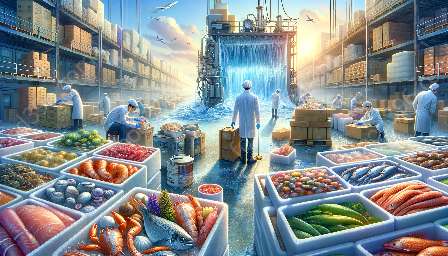Seafood packaging plays a crucial role in maintaining the freshness and quality of seafood products. There are various types of packaging designed to preserve seafood and extend its shelf life. Understanding the different packaging options, their benefits, and their compatibility with seafood storage and seafood science is essential for seafood industry professionals and consumers alike. Let's explore the various types of seafood packaging and their impact on storage and quality.
1. Fresh Packaging
Fresh seafood packaging is designed to maintain the natural freshness of seafood products. Common materials used for fresh seafood packaging include polystyrene foam containers or trays, vacuum-sealed bags, and modified atmosphere packaging (MAP) that includes the use of gas to extend the shelf life of the product. These packaging options help to prevent oxidation, dehydration, and microbial spoilage, preserving the quality and freshness of seafood. Proper storage conditions, such as refrigeration, are essential to complement fresh packaging and ensure the longevity of seafood.
2. Frozen Packaging
Frozen seafood packaging is crucial for preserving seafood products for an extended period. Common packaging materials for frozen seafood include polyethylene bags, vacuum-sealed pouches, and freezer-grade containers. The packaging must provide an effective barrier against moisture and air to prevent freezer burn and maintain the quality of the seafood. Additionally, proper storage and handling of frozen seafood are necessary to avoid temperature fluctuations and ensure the retention of moisture and texture during thawing.
3. Canned Packaging
Canned seafood is a popular and versatile packaging option that offers long shelf life and convenience. The canning process involves sealing seafood in airtight containers, typically tin-plated steel or aluminum, and subjecting it to heat to destroy bacteria and enzymes. This process ensures the preservation of seafood without the need for refrigeration. Canned seafood packaging is compatible with seafood storage as it provides a stable and durable solution for extended shelf life. Moreover, advances in canning technology have led to the development of premium quality canned seafood products with improved sensory attributes.
4. Vacuum Packaging
Vacuum packaging is an efficient method for extending the shelf life of seafood by removing air from the packaging and creating an oxygen-free environment. This type of packaging helps to prevent oxidation, microbial growth, and quality deterioration. Vacuum-sealed seafood products are often stored in refrigerated conditions to maintain their freshness and texture. It is crucial to consider the compatibility of vacuum packaging with seafood storage to ensure optimal preservation and quality retention.
5. Eco-Friendly Packaging
With increasing awareness of environmental sustainability, eco-friendly seafood packaging has gained prominence. This type of packaging includes materials such as compostable trays, biodegradable films, and recyclable materials that minimize environmental impact. Eco-friendly packaging aligns with seafood science by addressing concerns related to packaging waste and ecological footprint. Implementing eco-friendly packaging practices contributes to sustainable seafood storage and production, reflecting a holistic approach to seafood industry practices.
Impact on Seafood Storage and Quality
The choice of seafood packaging directly influences storage conditions and the overall quality of seafood products. Proper packaging helps to preserve the taste, texture, and nutritional value of seafood, contributing to consumer satisfaction and food safety. Understanding the impact of different packaging types on seafood storage and quality is essential for maintaining the integrity of seafood products throughout the supply chain. Whether it's maintaining freshness, extending shelf life, or minimizing environmental impact, the right packaging plays a pivotal role in seafood science and the seafood industry.

